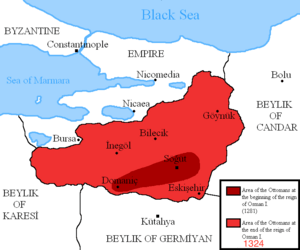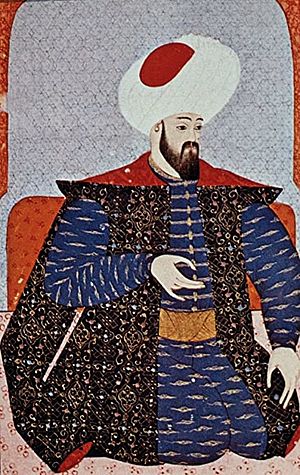Osman I facts for kids
Quick facts for kids Osmanسلطان عثمان غازى |
|||||
|---|---|---|---|---|---|
| Sultan of the Ottoman Empire | |||||
 |
|||||
| Reign | 1299–1326 | ||||
| Coronation | 1281 and 1299 | ||||
| Predecessor | New creation | ||||
| Heir Apparent | Orhan | ||||
| Born | 1258 Söğüt, Anatolia |
||||
| Died | 1326 (aged 68) Söğüt, Anatolia |
||||
|
|||||
| House | House of Osman | ||||
| Father | Ertuğrul | ||||
| Mother | Hayme Hatun | ||||
Osman I (born 1258, died 1326) was a very important leader. He was also known as Osman Gazi or Osman Bey. His nickname was "Kara," which means "black" in Turkish. This nickname showed how brave he was.
Osman was the leader of the Ottoman Turks. He founded the dynasty that created and ruled the Ottoman State. This powerful empire was named after him. It lasted for almost 600 years, until 1922.
In 1299, Osman declared his small kingdom independent from the Seljuk Turks. He became the leader, or Khan, of the Kayihan tribe. Many Muslim people moved to Osman's area in Anatolia. They were fleeing from the Mongol invasions. Osman quickly made his new state strong. As the Byzantine Empire became weaker, the Ottoman Empire grew to take its place.
Contents
How the Ottoman Empire Began
Osman I's father was named Ertuğrul. He led the Turkic Kayi tribe from Central Asia to Anatolia. They were escaping the Mongols. Ertuğrul's mother was named Khaima.
Ertuğrul promised to be loyal to Sultan Kayqubad I. This sultan was from the Seljuk principality of Rum. The sultan allowed Ertuğrul to create his own small state, called a beylik. He could expand it by taking land from the nearby Byzantine areas.
This location was perfect for growth. The rich Byzantine Empire was getting weaker to the west. In the east, Muslim groups under the Seljuk Turks were divided. They were busy fighting the Mongols and each other. The city of Baghdad had been sacked by Hulagu Khan in 1258. This was the same year Osman I was born. In 1231, Ertuğrul captured a Byzantine town called Thebasion. It was renamed Söğüt and became the first capital of his territory.
Osman became the chief, or Bey, after his father died in 1281. By this time, many fighters from all over the Islamic world came to his land. They wanted to fight against the weakening Byzantine Empire and take its treasures. Also, many Turkish people came to Osman's area. They were refugees escaping from the Mongols.
Many of these new people were Ghazi warriors. These were fighters for Islam. They believed they were fighting to spread or defend their religion. Osman was a strong and skilled leader. Under him, these warriors quickly became a powerful force. This is how the foundations of the Ottoman Empire were quickly built.
Osman was 23 years old when he became chief. He had already shown he was a great leader and warrior. Stories about his early adventures are popular. Especially famous are the love stories about how he won the beautiful Mal Hatun. Later writers made these legends even more romantic. Ottoman historians thought these dream-like stories about the empire's founder were very important.
Ottoman historians also liked to talk about the meaning of his name. "Osman" means "bone-breaker." This showed the strong energy that he and his followers would use in centuries of conquests. The name Osman is the Turkish version of the Muslim name Othman, or Uthman.
After the last prince of the Alaeddin family died, Osman had no strong rivals. He was the main leader of the Turks in the region. Only the Emir of Karamanids could challenge him. A long and fierce fight between Osman's family and the Karamanogullari princes began during Osman’s lifetime. It continued through the reigns of many of his successors.
Osman gained some advantages over his Karamanli rival. But the weak and rich lands of the Byzantine Emperor in northwest Asia Minor were more tempting. Osman wanted to conquer these lands. So, the victories of the last 26 years of Osman’s life were against the cities and armies of the struggling Byzantine Empire.
Osman I left a huge mark on history. He is remembered as the founder of a mighty empire. He is also a symbol of the Ghazi tradition. A large part of the Turkish people called themselves Osmanlı (Ottoman) until the dissolution of the Ottoman Empire.
Osman's Dream
Osman Gazi respected the ideas of the famous Ahi Sheikh, Sheik Edebali. Osman often visited Edebali at his home in Eskisehir. A group of dervishes, who are religious people, met there.
One night, Osman was a guest in Edebali’s home. He had a dream. When the sun rose, he went to Edebali and told him: "My Sheik, I saw you in my dream. A moon appeared in your chest. It rose, then came down into my chest. From my belly button, a tree grew. It grew and branched out so much that its shadow covered the whole world. What does my dream mean?"
After a short silence, Edebali explained:
"Congratulations Osman! God Almighty has given you and your family power to rule. My daughter will be your wife, and the whole world will be protected by your children."
Military Victories
In 1302, Osman's forces soundly defeated a Byzantine army near Nicaea. After this victory, Osman began to settle his forces closer to areas controlled by the Byzantines. Many Ghazi warriors, Islamic scholars, and dervishes started to move into areas controlled by Osman. These new people made up most of his army.
The arrival of so many Ghazi warriors and adventurers helped later Ottoman rulers. They began to call themselves "Sultan of Ghazis."
The Byzantines were worried about Osman's growing power. They slowly left the countryside of Anatolia. Instead, they focused their efforts on their Navy. Byzantine leaders wanted to stop Osman from crossing into Europe. They tried to limit Ottoman expansion to the west. However, Osman kept pushing westward. He captured the Byzantine city of Ephesus near the Aegean Sea.
Osman's power grew even more with the new people moving into his territory. He also moved eastward. He took over Byzantine lands in the Black Sea region of Anatolia.
Osman's last military action was against the Byzantine city of Bursa. He was old and did not fight in the battle himself. But the victory at Bursa was very important for the Ottomans. The city became a base for attacks against the Byzantines in Constantinople. It also became a new capital for Osman's son, Orhan.
Osman's Last Advice
Osman told his son to continue the rules set by Sheik Edebali. Osman said:
Son! Always put religious matters first. Religious rules build a strong state. Do not give religious duties to careless, faithless, or sinful people. Also, do not let such people manage the state. This is because someone who fears God the Creator will not fear anyone else. Someone who commits a great sin and keeps sinning cannot be loyal. Scholars, good people, artists, and writers are the strength of the state. Treat them with kindness and honor. Get to know good people and give them wealth and gifts. Make sure political and religious duties are in order. Learn from me: I came to these lands as a weak leader, but I received God's help even though I didn't deserve it. Follow my path and protect Din-i-Muhammadi (the religion of Muhammad) and its followers, as well as your own people. Respect the rights of God and His servants. Do not hesitate to advise your successors in this way. Rely on God's help to be fair and just, to stop cruelty, and to do your duties well. Protect your people from enemies and from cruelty. Do not treat anyone unfairly. Make your people happy and save them all.
The Sword of Osman
The Sword of Osman (Turkish: Taklide-Seif) was a very important sword of state. It was used during the ceremony when new sultans of the Ottoman Empire took the throne. This tradition began when Osman received the sword of Islam from his teacher and father-in-law, Sheik Edebali.
Putting on the Sword of Osman was a key ceremony. It happened within two weeks of a sultan becoming ruler. The ceremony took place at the tomb complex in Eyüp. This area is on the Golden Horn waterway in the capital city of Constantinople. The fact that a sword was used to crown a sultan was very symbolic. It showed that the sultan's main job was to be a warrior.
The Sharif of Konya would put the Sword of Osman on the new sultan. This Sharif was a Mevlevi dervish. He was called to Constantinople just for this purpose. This special privilege was given to religious leaders from Konya. This started when Osman made Konya his home in 1299. Later, the capital moved to Bursa and then to Constantinople.
Family and Children

Osman I married Malhun Hatun in 1280. She was the daughter of Ömer Bey. He also married Bala Hatun, who was the daughter of Sheikh Edebali.
Osman's children included:
- Alaeddin Pasha, who died in 1332.
- Orhan I, who was the son of Malhun Hatun.
Osman in Popular Culture
Osman is shown in the 2012 movie Fetih 1453. The actor Oğuz Oktay plays him. In the movie, Osman appears in Mehmed II's (Devrim Evin) dream. He tells Mehmed that he is the commander that Muhammad said would conquer Constantinople.
Images for kids
-
16th-century picture of Osman I by Paolo Veronese
-
Mongol soldiers, from Jāmiʿ al-tawārīkh by Rashīd al-Dīn al-Hamadānī
See also
 In Spanish: Osmán I para niños
In Spanish: Osmán I para niños















